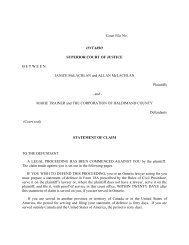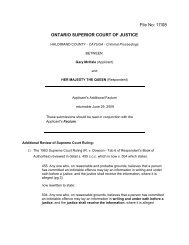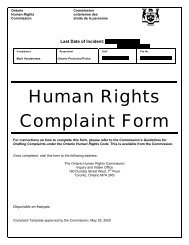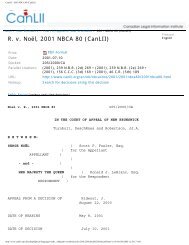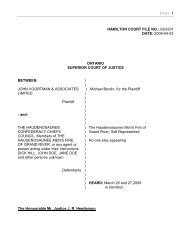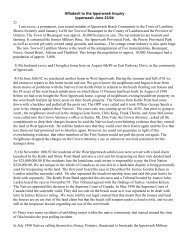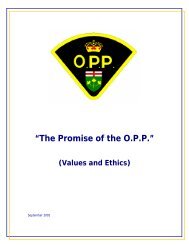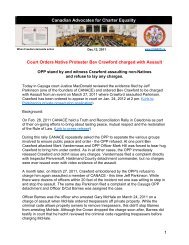Tanis Fiss, director Canadian Taxpayers Federation Centre for ...
Tanis Fiss, director Canadian Taxpayers Federation Centre for ...
Tanis Fiss, director Canadian Taxpayers Federation Centre for ...
You also want an ePaper? Increase the reach of your titles
YUMPU automatically turns print PDFs into web optimized ePapers that Google loves.
ROAD TO PROSPERITY – Five Steps To Change Aboriginal Policy1.1 Summary of RecommendationsRecommendation 1: Reallocate FundingIn order to increase the level of accountability on reserves, the paymentscurrently transferred to native band councils should be re-directed toindividuals. The money necessary <strong>for</strong> native governments could then be taxedback by the local native government. To ensure appropriate community support,this recommendation should be implemented on a pilot basis on one or morereserves over a set time-frame.Recommendation 2: Expand Auditor General’s MandateA system of independent annual financial audits and operational audits ofIndian governments – similar to how the federal and provincial auditors conducttheir audits of government departments and programs – should be implemented.Expansion of the current auditor general’s mandate to include native bands isimperative <strong>for</strong> greater accountability and transparency.Recommendation 3: Establish an Ombudsman <strong>for</strong> Aboriginal AffairsThe Indian Act does not sufficiently address the concerns of native <strong>Canadian</strong>s.As an interim measure to ensure native <strong>Canadian</strong>s receive appropriate redress,an Ombudsman <strong>for</strong> Aboriginal affairs needs to be established.Recommendation 4: Better Utilize Certificates of PossessionAs a way to promote private property ownership and prosperity in nativecommunities, Certificates of Possession should be better utilized.Recommendation 5: Amend Indian Act to Include Matrimonial Property RightsSince the Indian Act does not deal with matrimonial property rights, parliamentshould amendment the Indian Act to enable applicable provincial matrimoniallaw to apply to native reserves.<strong>Canadian</strong> <strong>Taxpayers</strong> <strong>Federation</strong>, <strong>Centre</strong> <strong>for</strong> Aboriginal Policy Change – 2005 2
ROAD TO PROSPERITY – Five Steps To Change Aboriginal Policy2.0 Increasing Accountability on Reserves<strong>Canadian</strong>s spend approximately $10 billion each year, in federal and provincialfunds, on aboriginal affairs. Regrettably, there is little to show <strong>for</strong> all thisspending. On many reserves, there is poor housing, poor schools, poor healthcare, and a third world standard of living.The Department of Indian Affairs is the primary agent of federal spending onIndians. It provides a range of services to status Indians and Inuit. Some of theareas the Department funds are: education, social support services, Indiangovernment support, social maintenance, construction and maintenance ofhouses, schools, roads, bridges, sewers and other community facilities,management of lands, oil and gas management and development, resourcesdevelopment, management of trust funds, community economic development,commercial development and Indian taxation services.There are 12 other federal departments which also fund status Indians: <strong>Canadian</strong>Heritage, Defense, Environment, Fisheries and Oceans, Foreign AffairsInternational Trade, Health, Human Resources Development, Industry, Justice,Natural Resources, Privy Council, and Solicitor General. In addition to federalgovernment support, provincial and municipal governments spendapproximately $3-billion per year on Indian, Inuit and Métis programs.The extent of duplication, and the overlap of expenditures and resources, isenormous. This is because the expenditures by federal departments, and manyprovincial and municipal agencies, are generally not property tracked or crossreferenced.According to auditor general reports, 80 per cent of the Department of IndianAffairs total expenditures are transferred directly to native bands. How thesefunds are disbursed is decided by the Chiefs and their band councils.In 1999, the Department of Indian Affairs reported that it had received some 300allegations ranging from nepotism to mismanagement of 108 Indian bands. Thatsame year, the federal auditor found the Department’s data to be "incomplete" atbest. "The Department does not have an overall picture of the nature andfrequency of the allegations… One regional office reported it did not know howmany allegations it had received during the past two years."The report also said: "The Department is not taking adequate steps to ensure thatallegations of wrongdoing, including complaints and disputes related to fundingarrangements, are appropriately resolved." Despite previous warnings about<strong>Canadian</strong> <strong>Taxpayers</strong> <strong>Federation</strong>, <strong>Centre</strong> <strong>for</strong> Aboriginal Policy Change – 2005 3
ROAD TO PROSPERITY – Five Steps To Change Aboriginal Policyaccountability problems, in the April 1999 report, the federal auditor found theDepartment of Indian Affairs relied too heavily on "self-assessments" by bandsevaluating their own fiscal management, without determining whether thoseinternal band reviews were accurate.Accountability on native reserves is lacking but there are ways to solve thatproblem. One possibility is to have native governments collect taxes in the wayother levels of government collect taxes: through income taxes, property taxesand a multitude of other measures. This would have an immediate effect on thesize of government on reserves, which is unreasonably large in comparison tonon-native communities of similar sizes.For example, <strong>for</strong> the year ending March 31, 2002, there was one native politician<strong>for</strong> every 175 people. These politicians earned salaries and honoraria ofapproximately $101 million tax-free. The travel expenses <strong>for</strong> the nativepoliticians were another $30 million. 1 That same year, the city of Calgary had 15elected officials; meaning one politician <strong>for</strong> every 60,000 Calgarians. The salariesand honoraria of Calgary’s elected officials were approximately $1.1 million.The Samson Cree Reserve in Alberta provides a tragic example of the power andlack of accountability displayed by some native chiefs and councils.Samson Reserve near Edmonton sits on one of the largest oil and gas fields in thecountry; it accounts <strong>for</strong> 75 percent of total oil and gas production on Canada’sreserves. In 1996, band revenue was nearly $100 million, about half of it comingfrom the federal and provincial governments. 2 Since the reserve system is basedon a communal arrangement, reserve resources are to be shared among the bandmembers. The Samson Reserve has approximately 5,000 members.Un<strong>for</strong>tunately, sharing doesn’t readily occur on the Samson Reserve. Nearly 80percent of the residents are on welfare, and unemployment is approximately 85percent.On the other side, there is a small group of band leaders and connected insidersthat control the reserve’s affairs and finances. Some collect tax-freecompensation packages that place them in the top few percent of the country’sincome earners. These leaders travel to Geneva, London, Paris, Turin, Tokyo andcountless other places. They attend events across Canada and the United States.They hold meetings in Las Vegas. 3Because the ruling elite on the reserve control all aspects of reserve life, they canpunish and they can reward. And at election time, they can use the reserve’smoney to buy support. In 1998, the Samson Band had a budget of $100,000 tocover the costs of band members seeking favours and money in return <strong>for</strong><strong>Canadian</strong> <strong>Taxpayers</strong> <strong>Federation</strong>, <strong>Centre</strong> <strong>for</strong> Aboriginal Policy Change – 2005 4
ROAD TO PROSPERITY – Five Steps To Change Aboriginal Policyelectoral support. An audit revealed, however, that the chief and council handedout $1.29 million in election goodies. 4To avoid a repeat of the Sampson experience, the entire funding structure needsto change. Federal payments should be directed to the individual band members<strong>for</strong> whom the support is needed, not band governments and their chiefs.Different arrangements may be needed. For example, if the federal governmentwithheld money from a cheque directed to an individual native (and so noted onthe cheque), and transferred the money to the native government in question ––that alone would inject better accountability into the system than now exists.After all, it works now to a degree <strong>for</strong> local, provincial and federal governments.As the French Finance Minister Colbert once remarked that the art of taxationconsists in plucking feathers from the goose with the least amount of hissing.Reserve governments should be subject to the discipline of hissing taxpayers.This would gradually reduce the excessive size of government on reserves.Recommendation 1: Reallocate FundingIn order to increase the level of accountability on reserves, the paymentscurrently transferred to native band councils should be re-directed toindividuals. The money necessary <strong>for</strong> native governments could thenbe taxed back by the local native government. To ensure appropriatecommunity support, this recommendation should be implemented on apilot basis on one or more reserves over a set time-frame.Rearranging federal transfers to Indians will not reduce dependency. It ishowever, a small step <strong>for</strong>ward in the provision of greater freedom of choice andpersonal responsibility. It will be up to the individuals to decide what types ofservices their local government will provide with their tax dollars. Individualnatives may wish <strong>for</strong> their band governments to improve housing or sewagerather than continuing to subsidize local businesses. The process of individualsdeciding which services they wish to receive over others will provide nativeswith a greater sense of responsibility.2.1 Auditor General of CanadaThe auditor general of Canada is an independent audit office serving parliamentand <strong>Canadian</strong>s, and is widely respected <strong>for</strong> the quality and impact of its work.The auditor promotes accountable government, and an ethical and effectivepublic service.<strong>Canadian</strong> <strong>Taxpayers</strong> <strong>Federation</strong>, <strong>Centre</strong> <strong>for</strong> Aboriginal Policy Change – 2005 5
ROAD TO PROSPERITY – Five Steps To Change Aboriginal PolicyThe auditor general’s office is able to achieve its goals by conductingindependent audits and studies that provide objective in<strong>for</strong>mation, advice, andassurance to parliament, government, and <strong>Canadian</strong>s by working collaborativelywith legislative auditors, federal and territorial governments, and professionalorganizations.Un<strong>for</strong>tunately, once the federal government transfers money (tax dollars) fromthe federal departments to native bands, the auditor general of Canada no longerhas the authority to audit how and where the money is spent. No checks andbalances foster inefficiencies, redundancies, corruption and even abuse.If the ultimate goal is to eventually have all <strong>Canadian</strong>s treated with the samerights and responsibilities regardless of race or ancestry, then creating anotherseparate office of the auditor general may not be the best route to achieve thegoals or the best use of tax dollars. The expansion of the existing auditorgeneral’s mandate to include native bands would not require as many tax dollarsto operate due to the economies of scale that could be utilized, and the standardof audits, mandates and scrutiny would remain consistent. The audits woulduncover waste, mismanagement, and corruption and will provide band membersand taxpayers with an indication of the efficiency, effectiveness and quality ofservices being offered with tax dollars on reserves.Recommendation 2: Expand Auditor General’s MandateA system of independent annual financial audits and operational auditsof Indian governments – similar to how the federal and provincialauditors conduct their audits of government departments and programs– should be implemented. Expansion of the current auditor general’smandate to include native bands is imperative <strong>for</strong> greater accountabilityand transparency.Both taxpayers and native <strong>Canadian</strong>s would benefit from the increasedaccountability, transparency and scrutiny. The increased knowledge wouldenable native community members to adequately evaluate the programs andservices offered in their community in order to decide which programs andservices should be continued, and which ones should be terminated. Thisprocess will ultimately save taxpayers and native communities valuable time,money and resources.2.2 Ombudsman <strong>for</strong> Aboriginal AffairsEvery office of the <strong>Canadian</strong> <strong>Taxpayers</strong> <strong>Federation</strong> receives calls from native<strong>Canadian</strong>s on occasion, frustrated with their local council, or frustrated with theDepartment of Indian Affairs.<strong>Canadian</strong> <strong>Taxpayers</strong> <strong>Federation</strong>, <strong>Centre</strong> <strong>for</strong> Aboriginal Policy Change – 2005 6
ROAD TO PROSPERITY – Five Steps To Change Aboriginal PolicyPresently, the delivery of programs is in the hands of the chief and council. Sincethere is little separation between politics and administration on reserves – andthere is no requirement to do so – everything on a reserve that is in any wayrelated to band administration is politicized. This scenario provides the chiefand council with tremendous power and control over community members.This power is often abused. Many <strong>Canadian</strong>s are familiar with media accountsof corruption and mismanagement of reserve funds. For example, as per bandfinancial documents, leaders of the Alexander Native Band of Alberta authorizedat least $108,868 in cheques to dozens of voters on the eve of the September 12,2002 election. Six members of the Alexander Band swore affidavits in FederalCourt saying they were paid on the understanding they would vote <strong>for</strong>incumbent candidates <strong>for</strong> chief and band council. Three of them received $150 or$200, according to the band administration’s general cheque ledger. 5In January 2005, it was reported the Labrador Innu Band Council of Natuashishcould not account <strong>for</strong> $3 million in a recent audit. The band later indicated only$300,000 could not be accounted <strong>for</strong>. Band members allege alcohol wasdistributed during the last band council elections.As a result of the poor accounting practices and allegation of “vote-buying”Natuashish community members organized a petition calling <strong>for</strong> the chief to befired and sent the petition to the Department of Indian Affairs. Regrettably,Indian Affairs Minister Andy Scott did not launch an investigation, but passedthe buck to the RCMP to lay charges upon receipt of a complaint. Thus, theconcerned band members are caught in a vicious circle with little hope of redressin sight.Un<strong>for</strong>tunately, these are not isolated incidents.Access to In<strong>for</strong>mation documents obtain by the <strong>Canadian</strong> <strong>Taxpayers</strong> <strong>Federation</strong>show in 2003 the Department of Indian Affairs received 297 allegations ofcorruption, nepotism or mismanagement by native band councils.As an interim measure to ensure native <strong>Canadian</strong>s receive appropriate redress,an Ombudsman <strong>for</strong> Aboriginal affairs needs to be established. In keeping withthe CTF’s objectives of the eventual elimination of the Indian Act and theDepartment of Indian Affairs, the Ombudsman <strong>for</strong> Aboriginal affairs wouldeventually become redundant.That said, the ombudsman would have authority to investigate complaints andpropose changes to be made in a band’s administrative practices or theadministrative practices of the Department of Indian Affairs. If the band or the<strong>Canadian</strong> <strong>Taxpayers</strong> <strong>Federation</strong>, <strong>Centre</strong> <strong>for</strong> Aboriginal Policy Change – 2005 7
ROAD TO PROSPERITY – Five Steps To Change Aboriginal PolicyDepartment fails to make those changes, a report would be brought be<strong>for</strong>eParliament.Recommendation 3: Establish an Ombudsman <strong>for</strong> Aboriginal AffairsThe Indian Act does not sufficiently address the concerns of native<strong>Canadian</strong>s. As an interim measure to ensure native <strong>Canadian</strong>s receiveappropriate redress, an Ombudsman <strong>for</strong> Aboriginal affairs needs to beestablished.Under the current system, native <strong>Canadian</strong>s are caught between a rock and ahard place when they raise concerns over their chief and councils per<strong>for</strong>mance.In many cases, neither the native band nor the Department of Indian Affairswishes to address the concerns. An Ombudsman <strong>for</strong> Aboriginal affairs – with asunset clause – would provide native <strong>Canadian</strong>s with an independentinvestigative authority to address concerns over alleged native band misconduct.3.0 Wealth Creation Through PropertyMillions of <strong>Canadian</strong>s take the right to buy and sell their own home <strong>for</strong>granted. Yet on Canada's reserves, where land is held communally, aboriginalshave been systematically denied this fundamental economic right <strong>for</strong>generations.The news from Natuashish is bleak. In 2002, the federal government spent$152-million relocating Labrador's Mushuau Innu to the newly constructedcommunity, hoping the epidemic of unemployment, suicide and substanceabuse that had plagued their decrepit Davis Inlet settlement would abate. But arecent in-depth investigation per<strong>for</strong>med by the CBC shows conditions amongthe Innu are worse than ever. Drug and alcohol use is still rampant, the localeconomy is virtually non-existent, and now it is reported that $3-million inband funds have gone missing.Sadly, Natuashish is all too typical of other aboriginal communities. Under theIndian Act, natives have been encouraged to remain on reserves, where land isheld in trust by the Crown and controlled collectively by band councils, not byindividuals. This communal arrangement, which resembles the collectivefarming model implemented disastrously under Soviet communism, stiflesindividual entrepreneurship: Because landholders do not own their property infee simple, they may not obtain mortgage financing, the most common method<strong>for</strong> small business owners to raise start-up capital.<strong>Canadian</strong> <strong>Taxpayers</strong> <strong>Federation</strong>, <strong>Centre</strong> <strong>for</strong> Aboriginal Policy Change – 2005 8
ROAD TO PROSPERITY – Five Steps To Change Aboriginal PolicyIndeed, the arrangement gives landowners little motivation to improve theirproperty or build equity of any kind within their community. The policythereby stifles economic development, and promotes unemployment andidleness - as well as the ills that follow in their wake.Some reserves have attempted to promote economic development through socalled"customary" or "hereditary" rights. Under such an arrangement, someband councils allot parcels of reserve land to families and individuals whohave lived on that land <strong>for</strong> a long period of time. However, such in<strong>for</strong>malrights are more limited than the outright fee-simple ownership most <strong>Canadian</strong>property owners take <strong>for</strong> granted. In many cases, customary rights may beexercised only <strong>for</strong> residential or agricultural use, not commercial purposes.Moreover, although holdings can be passed on to heirs and subdivided amongfamily members, they cannot be sold to an unrelated third party. Nor can theybe seized by banks or other financial institutions, which explains why theycannot be used as mortgage collateral.Since it's the band that assigns customary rights, it's the band that handles anydisputes that arise over ownership. (The federal government does notrecognize customary rights, as such rights lie outside the purview of the IndianAct). Since owners cannot invoke the powers of the <strong>Canadian</strong> legal system toprotect their interest in a given parcel of land, they are liable to dispossessionbased on arbitrary or even corrupt decisions emanating from band councils.The link between land ownership and prosperity is well-known to economists.Yet land re<strong>for</strong>m remains elusive because <strong>Canadian</strong> governments and nativeleaders remain wedded to the idea that reserve land should be ownedcollectively. Courts have played a role as well. In 2001, <strong>for</strong> instance, the B.C.Supreme Court ruled in the case of Lower Nicola Indian Band v. Trans-CanadaDisplays Ltd. that a band council holds a fiduciary obligation to all bandmembers, and must there<strong>for</strong>e consider the rights of other bandmembers in decisions involving the use of property.In the Nicola case, a band member had claimed possession of 80 acres ofreserve land based on customary use, and had entered into an agreement witha company to display billboards on that land. After his death, his estateclaimed the property. The court, however, held that customary use did notcreate a legal interest in the land; and that until permission was given by theband or the government, the company displaying billboards would be deemedto be trespassing on reserve lands.It is also common <strong>for</strong> disputes to arise over property rights during divorceproceedings. Courts trying to divide up on-reserve property have no recourse<strong>Canadian</strong> <strong>Taxpayers</strong> <strong>Federation</strong>, <strong>Centre</strong> <strong>for</strong> Aboriginal Policy Change – 2005 9
ROAD TO PROSPERITY – Five Steps To Change Aboriginal Policyto provincial family law, but must instead rely on the federal Indian Act, whichcontains no provisions <strong>for</strong> distribution of property upon the breakdown of amarriage. In normal situations that arise off-reserve, a house can be sold andthe proceeds split between divorced parents. That is usually impossible onreserves. And because tribal councils often side with the ex-husband indomestic disputes, it is not uncommon <strong>for</strong> wives to be turfed out of theirhomes, and off the reserve entirely.For all of these reasons, it is clear that customary rights are a poor way tomanage the private use of land on aboriginal reserves.3.1 A Step Toward Better Native HousingPride of ownership provides a powerful motivation <strong>for</strong> individuals to improvetheir property. It explains why homeowners are willing to spend theirweekends fixing their houses and mowing their lawns. The reason they do so isbecause the property is theirs and theirs alone. They own it in "fee simple" -that is to say, outright. As the well-known expression goes, no one ever paidmoney to wash a rented car.As a visit to a typical <strong>Canadian</strong> reserve reveals, such pride of ownership isabsent in many native communities. Housing is dilapidated, and there is littleevidence that occupants care much about their properties.Needless to say, this is not a reflection of aboriginals themselves, but rather anindictment of our government's native policy: Federal law does not permitthose who live on Indian reserves to own their homes in fee simple. Since theycannot sell their houses to recover their investments, residents have noeconomic incentive to spend money on improvements. For the same reason,there is no reason <strong>for</strong> housing developers and other entrepreneurs to createnew building stock <strong>for</strong> private buyers.This explains why a 2003 federal auditor general (AG) report found there was ashortage of 8,500 houses on Canada's Indian reserves - despite the fact thefederal government spent $3.8-billion over the past decade on native housing.As things currently operate, the Department of Indian Affairs and the CanadaMortgage and Housing Corporation (CMHC) transfer federal housing moneydirectly to native band councils. From there, it is up to the chief and council todetermine who gets a new house or repairs. As one would expect in any systemin which material benefits are dolled out by unaccountable leaders, bald-facedfavouritism is common. In many cases, reserve residents complain, one must be<strong>Canadian</strong> <strong>Taxpayers</strong> <strong>Federation</strong>, <strong>Centre</strong> <strong>for</strong> Aboriginal Policy Change – 2005 10
ROAD TO PROSPERITY – Five Steps To Change Aboriginal Policyconnected to the band council in some way in order to obtain new or improvedhousing.Even well-intentioned native leaders have difficulty fulfilling their oversightresponsibilities. For instance, band councils are supposed to ensure that anynew housing meets National Building Code standards. But bands often have noway to ensure new housing meets these codes, which helps explain the highpercentage of substandard housing.The average non-native homeowner can walk away from a housing purchase ifthe dwelling is poorly constructed: In a free market, he has a thousand otherhomes from which to choose. But on reserves, residents have no choice: Likethe citizens of some bygone communist regime, they must take what theirpolitical masters give them, whether it’s falling apart or not.Because fee-simple ownership of reserve land is <strong>for</strong>bidden, systems of whatmay be called "quasi-ownership" have emerged. One such system, customaryrights, was discussed earlier (along with its various flaws). Another morepromising alternative is the allotment of "Certificates of Possession" (COP).When a band issues a COP, the landholder is deemed to have an interest in theproperty he inhabits. This interest may then be used to apply <strong>for</strong> mortgagefinancing, which is otherwise unavailable to reserve residents.In return <strong>for</strong> a loan, a holder of a COP transfers his certificate back to theissuing band as collateral. The band then enters into an agreement with CMHCby which it pledges to assume the mortgage in the event of a default. SinceCOP holders can be dispossessed if they do not meet their repayment schedule,they will generally be motivated to comply with the terms of their loan. Oncethe mortgage is paid off, the certificate is transferred back to the individual.Certificates of Possession are a stronger and more valuable <strong>for</strong>m of propertyrights than customary or hereditary ownership: <strong>Canadian</strong> courts will en<strong>for</strong>cethe rights and obligations associated with COPs, whereas they typically willnot in the case of customary rights. And since land held under a COP can besubdivided, left to an heir or sold to another person having a right to reside onthat reserve, certificate holders tend to assume the mindset and habits of a trueproperty owner.Many native bands across Canada have been motivated to issue Certificates ofPossession because they are a means to bring more funding to the reserve.Moreover, the economic value that inheres to COPs provides an enticement <strong>for</strong>younger band members to stay on-reserve. In some parts of Canada, internalreal estate markets powered by COPs are thriving. The Six Nations Band in<strong>Canadian</strong> <strong>Taxpayers</strong> <strong>Federation</strong>, <strong>Centre</strong> <strong>for</strong> Aboriginal Policy Change – 2005 11
ROAD TO PROSPERITY – Five Steps To Change Aboriginal PolicyOntario, <strong>for</strong> instance, has issued over 10,000 COPs.Recommendation 4: Better Utilize Certificates of PossessionAs a way to promote private property ownership and prosperity innative communities, Certificates of Possession should be betterutilized.In sum, Certificates of Possession are win-win-win: Bands are able to securemore income; residents become eligible <strong>for</strong> mortgage financing; and <strong>Canadian</strong>taxpayers are relived of some of the burden associated with the constantreplenishment of native housing stock. One can only hope that more ofCanada's reserves follow the example of the Six Nations Band.3.2 Matrimonial Property RightsWhether it is a <strong>Canadian</strong> government sanctioned report or a United Nations’study, native <strong>Canadian</strong> women and children living on Indian reserves, are themost disadvantaged of all <strong>Canadian</strong> citizens. The lack of matrimonial propertyrights is one reason <strong>for</strong> the disparity.Throughout Canada, provincial family law governs the division of assets andchild custody upon dissolution of marriage. Yet because Canada’s constitutionstipulates the federal government has exclusive jurisdiction over “Indians andlands reserve <strong>for</strong> the Indians,” the federal Indian Act is the law that ultimatelygoverns native <strong>Canadian</strong>s living on reserves.<strong>Canadian</strong> courts have ruled that only the Indian Act can apply to property onreserves – regrettably, the Indian Act is mute on the subject of matrimonialproperty rights. According to the Department of Indian Affairs, native bandsoperating under the Indian Act can adopt policies to govern the granting ofallocations of land that take into account matrimonial real propertyconsiderations.It is true the First Nations Land Management Act does deal explicitly with thedivision of matrimonial property, however the development of land codes are acommunity responsibility. In many cases this is little if any improvement overthe status quo.The land possession system of the Indian Act does not prohibit women frompossessing property on reserves, however, the Department of Indian andNorthern Affairs has indicated most certificates of possession are held by nativemen. This is an important point since property rights on reserves determine<strong>Canadian</strong> <strong>Taxpayers</strong> <strong>Federation</strong>, <strong>Centre</strong> <strong>for</strong> Aboriginal Policy Change – 2005 12
ROAD TO PROSPERITY – Five Steps To Change Aboriginal Policychild custody and access rights. Native men have the upper hand when it comesto child custody and divorce settlements.Women must ask their band council if they may stay in their family house and ifthey may retain custody of their children. As indicated earlier, property rightson reserves determine child custody and access rights, leading to many nativewomen to not only become homeless, but lose custody and access to theirchildren.There are several ways to alleviate these situations. Two solutions would be toamend the Indian Act to incorporate the applicable provincial matrimonial lawor provide <strong>for</strong> individual private property rights on reserves.Since the Indian Act does not deal with matrimonial property rights, it wouldrequire a parliamentary amendment to change that. True, the constitution givesthe federal government exclusive jurisdiction over native reserves; this does notmean however that the federal government can not delegate some of itsjurisdiction. A simple parliamentary amendment could allow <strong>for</strong> the appropriateprovincial marriage laws to apply on reserves.Reserve land is now held in trust by the <strong>Canadian</strong> government and not by thenative <strong>Canadian</strong> community members. This land needs to be transferred to theindividuals of the native community. This would enable the native communitiesto establish individual private property rights, thereby providing women – andmen – greater certainty over property ownership. This is a lofty goal; one theCTF has commented extensively on in other studies.Recommendation 5: Amend Indian Act to Include MatrimonialProperty RightsSince the Indian Act does not deal with matrimonial property rights,parliament should amendment the Indian Act to enable applicableprovincial matrimonial law to apply to native reserves.As more and more aboriginal women’s organizations are established throughoutCanada, <strong>Canadian</strong>s will become more aware of the plight of native women andchildren who live on reserves. Given the speed at which politicians have dealtwith native issues in the past, it will likely take a great deal of public pressure to<strong>for</strong>ce the politicians to act <strong>for</strong> the benefit of aboriginal women and children. Forthe sake of native women and children, let’s hope they move quickly on thisissue.<strong>Canadian</strong> <strong>Taxpayers</strong> <strong>Federation</strong>, <strong>Centre</strong> <strong>for</strong> Aboriginal Policy Change – 2005 13
ROAD TO PROSPERITY – Five Steps To Change Aboriginal Policy6.0 Footnotes1 Department of Indian Affairs, 2001-2002 Schedules of Salaries, Honoraria and Travel Expenses providedby First Nations2 Remington, R. 2000. “Cree band seeks $1.4B in lawsuit against Ottawa.” National Post. June, 2000.3 Cheney, P. 1999. “The money pit: an Indian band’s story.” The Global and Mail. April 1999.4 Cheney, P. 1998.” The Global and Mail. October 24, 1998.5 Perreauz, Les. 2002 “Cheques issued on eve of election.” National Post. December 2002.<strong>Canadian</strong> <strong>Taxpayers</strong> <strong>Federation</strong>, <strong>Centre</strong> <strong>for</strong> Aboriginal Policy Change – 2005 15



